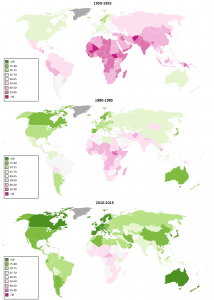
Some people have criticized me for being overly pessimistic in my op-ed piece – “The Worst Is Yet To Come” – and for being in complete contrast to the expectations of the entire planet that the “good old world” from 2019 would return after vaccination.
This time around, I will try to use “lighter tones”.
A few days ago, I saw a life expectancy map for 1800, 1950, and 2015. From an average of 29 years of age, on the global level, in 1800 (Europe 34, America 35, Africa 26, Asia 28, Oceania 35), through to the global average of 46 years of age in 1950, to as many as 71 years of age as the average in 2015 – the civilization’s progress has been enormous. These maps also show the progress of medicine, the reduction of poverty and the declining number of deaths as a result of wars and revolutions.
Do we really live in “the best of all possible worlds”? This is quite the opposite of what the main characters in Woody Allen’s film “Midnight in Paris” think, who are constantly returning to the past, believing that that era was the best.

The phrase “the best of all possible worlds” (in French: “le meilleur des mondes possible”; in German: “Die beste aller möglichen Welten”) was coined by the German polymath Gottfried Leibniz in his 1710 work Essais de Théodicée sur la bonté de Dieu, la liberté de l’homme et l’origine du mal (Essays of Theodicy on the Goodness of God, the Freedom of Man and the Origin of Evil). The claim that the actual world is the best of all possible worlds is the central argument in Leibniz’s theodicy, or his attempt to solve the problem of evil.
If we were to survey Europe’s population, they would certainly say that, in 2020, they lived in “the worst of all possible worlds”. However, despite the pandemic, closed bars, restaurants and shops, the facts still say the opposite. Except in regard to environmental protection, the planet Earth is today in the best condition ever – we have the lowest number of people dying in wars, the lowest number of terrorist attacks and the lowest number of people who are hungry and poor.
So, take a look at these maps every time you overindulgently and ungratefully think – “It’s never been worse! I can’t drink my espresso in my favourite café like I’m used to.”